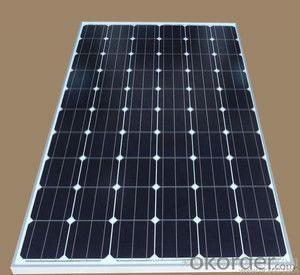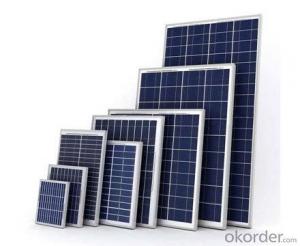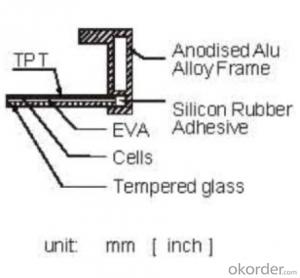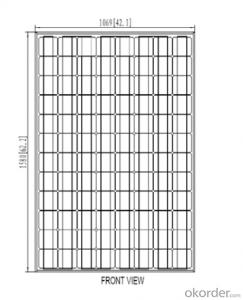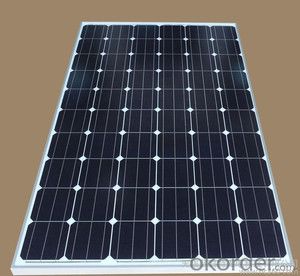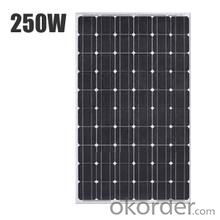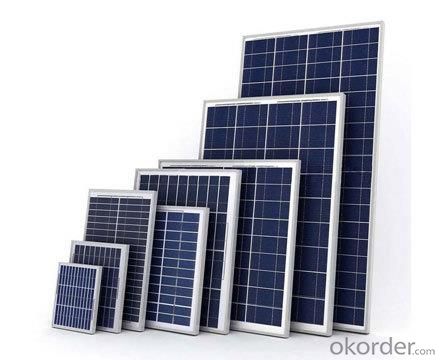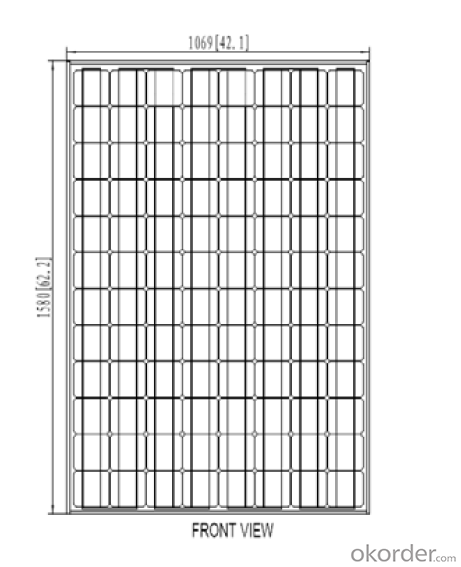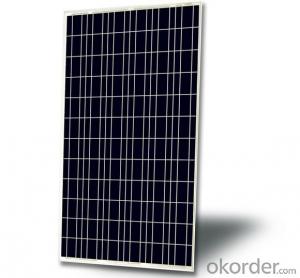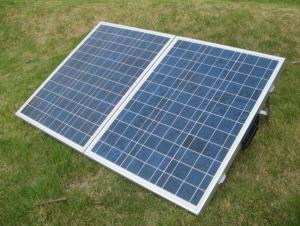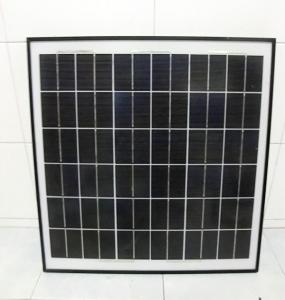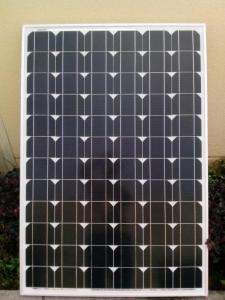CSP Solar Panels - Solar Monocrystalline Series S2 (240W-260W)
- Loading Port:
- China main port
- Payment Terms:
- TT OR LC
- Min Order Qty:
- 5000 watt
- Supply Capability:
- 45000000 watt/month
OKorder Service Pledge
OKorder Financial Service
You Might Also Like
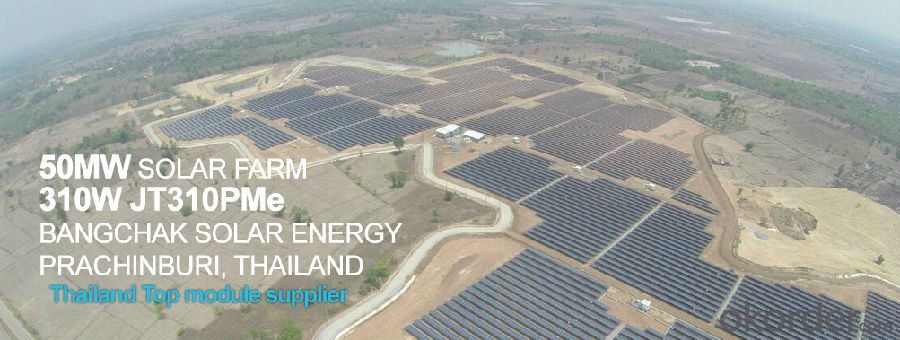
A Grade 250w high efficiency Poly PV Solar panels
Max Power Voltage Vmp(V) | 31.5 |
Max Power Current Lamp(A) | 7.94 |
Open Circuit Voltage Voc(V) | 37.5 |
Short Circuit Current Isc(A) | 8.72 |
Temperature Coefficients of Isc (%/℃) | 0.0825 |
Temperature Coefficients of Voc (%/℃) | -0.4049 |
Temperature Coefficients of Pmp (%/℃) | -0.4346 |
Max Power(w) | 250 |
Mechanical & Limits Data
Dimension (mm) | 1640*992*40 |
NO of Cells and Connections | 60(6x10) |
Weight(kg) | 18.5 |
Tolerance | 0~+5% |
Cell | Polycrystalline Cell 156 x 156 mm |
Operating Temperature | –40 °C to +85°C |
Max System Voltage(VDC) | 1000 |
Packing | 312PCS/20ft(H) Container |
Products Detailed Pictures
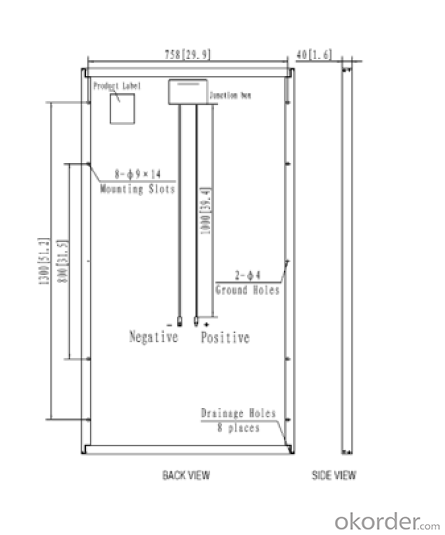

Off-grid PV system consists of of the solar modules, charge controller, inverter and battery banks etc.
PV array:
Convert sunlight instantly into DC electric power. Formed by the solar modules (also called photovoltaic
modules) in accordance with the system requirements for series and parallel.
Solar charge controller:
A charge controller may be used to power DC equipment with solar panels. The charge controller
provides a regulated DC output and stores excess energy in a battery as well as monitoring the battery
voltage to prevent over charge or over discharge. An inverter can be connected to the output of a charge
controller to drive AC loads.
Inverter:
Converts DC output power of photovaltaic soalr panels into standard AC power for use in the local off-grid
electrical network. It is a critical component in a photovoltaic system, allowing the use of ordinary
commercial appliances.
Battery banks:
Stores energy when there is an excess coming in and distribute it back out when there is a demand. Solar
PV panels continue to re-charge batteries each day to maintain battery charge.

We are a Quality + Service oriented company with“Excellence at Each Step” approach, composed of the finest
components from TUV and IEC-certified partners around the world, Our modules consistently undergo a variety of
trials at the company’s Test & Development Centre, ensuring peak performance capabilities. The company is
committed to develop and provide the world with clean and renewable energy to ease the energy shortages as well
as human kind’s impact on the environment.
Solar system advantages:
1. CE, ROHS approved.
2. High conversion efficiency, high-transmission rate.
3. Energy saving, environmental-friendly.
4. Advanced technology, strict quality control system.
5. Easy installation, safe operation, free maintenance.
6. Low MOQ, fast delivery time, long service life

Our Advantage
1. High efficiency and High power.
2. Long-term electrical stability.
3. Lowest price and Fastest delivery.
4. Good quality and good service.
5.Bulk supply
6. Good Warranty
7.Big Sale
8.High quality
9.More than 35 years on the lifetime.
10 DHL/Fedex/UPS/TNT/EMS etc
It can load household appliances like TV, Air Conditioner, refrigerator, lighting, washing machine, etc.It can be applied to the villa, household, tourist resorts, prairie areas, remote mountain village, no power supply areas, farms, villages, island, highway and any regions to generate electricity.
Features--- Solar Generator System for Home
1.100% photovoltaic storage system, domestic power supply.
2.New green energy applicable to household appliances, TV and phone charging, etc.
3.Equipped with various safety devices.
Remark: The sunshine rediation will affect the charge time, so we will supply you perfect design according to your local climate.
Benefits of Solar Power:
Now is a great time to go solar and harvest the power of the sun. Here is our top ten list of the benefits to installing solar power:
1, When installed, solar energy is free – no resources are consumed
2, Help to lessen our dependence on heavily polluting coal power stations
3, Fossil fuels can't last forever, future generations will appreciate the effort
4, You are gaining energy independence - add battery backup power for even greater energy security
5, The cost of electricity is only going to rise – insure against that rising cost
6, Quality solar power and water adds value and appeal to your home
7, Solar PV systems are easily upgraded in future - aim to make your house a net energy producer!
8, Solar panels offer a long lifetime of low maintenance service, maybe 30-40 years
9, Your friends will think you're great!
10, You'll feel great for doing your bit for the environment!
FAQ
We have organized several common questions for our clients,may help you sincerely:
1.what price for each watt?
it depends on the quantity, delivery date and payment terms,
2.what is your size for each module? can you tell me the parameter of your module?
we have different series of panels in different output, both c-si and a-si. please take the specification sheet for your reference.
3.Can you provide the peripheral products of the solar panels, such as the battery, controller, and inverter? If so, can you tell me how do they match each other?
Yes, we can, we have two companies for solar region, one is CNBM International, the other is CNBM engineering Co.
We can provide you not only the solar module but also Solar Cells, the off grid solar system, we can also provide you service with on grid plant.
4What is your warranty system?
Our product performance guarantees for 25 years
• 12 years guarantee for workmanship
• Timeliness of delivery
• Quality Products certified (TÜV, UL, CE, ISO)
5.How do you pack your products?
We have rich experience on how to pack the panels to make sure the safety on shipment when it arrives at the destination.
6. Can you do OEM for us?
Yes, we can.
7.How long can we receive the product after purchase?
In the purchase of product within three working days, We will arrange the factory delivery as soon as possible. The pecific time of receiving is related to the state and position of customers. Commonly 7 to 10 working days can be served.
- Q: How do solar panels affect wildlife?
- Solar panels can have both positive and negative effects on wildlife. On the positive side, solar panels can provide a habitat for certain species, such as birds or insects, as they can create shaded areas or serve as perches. Additionally, solar farms often have vegetation underneath or around the panels, which can attract and support a diverse range of wildlife. However, there are also potential negative impacts to consider. Large-scale solar projects can disrupt or destroy natural habitats, leading to the displacement or loss of certain species. Additionally, solar panels can pose a risk to birds and other flying animals if they are not properly designed or installed. Glare from the panels may also impact wildlife behavior or migration patterns. Overall, it is important to carefully plan and manage solar installations to minimize any negative impacts on wildlife while maximizing the benefits they can provide.
- Q: Can solar panels be installed on historic homes or buildings?
- Yes, solar panels can be installed on historic homes or buildings. However, it is important to consider the specific regulations and guidelines set by local historic preservation boards or authorities. In many cases, there are alternative installation methods available that minimize any visual impact on the historic aesthetics of the building. It is advisable to consult with experts in historic preservation and solar installation to ensure compliance with any necessary requirements.
- Q: looking for a solar panel to charge my laptop on the road, macbook is 60 watt 6.v 3.5a, what should i be looking for in a solar panel?
- Well that's a good idea,,,here's what ya need..First you need an array that will overcome the drain effect created by the in use or sleeping laptop...that is best solved by averaging out the real use of the machine in terms of watt/minutes...If you check your transformer you'll see it has a capacity which you have cited however the true use of the computer is about 40-50 percent of that in watt/minutes..but only while your using it and when in the sleep mode the watt/minute value drops even more to about 5%.... So if your actual use consists of 2 hours of use per day at 50% and 2 hours at 5% percent the actual wattage draw is only averaged out at 34watts/minute. optimally your panel should supply all your power from its photovoltaic conversion ,but in the real world application the panel only recharges ,over a period of time, the used power. So if you had a 5 watt (@ 2vdc) panel working 480 minutes and used up 35 x2=700 and 9 x2=8 for a total of 78 watts you would have 5 x 480 = 7200 watts input and a parasitic load of 78 watts in the two hours...well within the recharge state required.. For a little safety I would permanently wire a cigarette lighter type plug to the end of the panel this will keep the polarity correct and serve as a quick disconnet means...Also add a fuse at .5 amp... a good place to get these are on the internet....some are very expensive some a very cheap --go for a middle of the roader...Have a good one from the E...
- Q: Solar panels would change the world if they were widely available to us especially cheap, it will be worth it in the long end. Money would be saved like housands a year per person on utility costs.
- Down the drain. That money is gone. Just more wasted money the government writes off and then tries to raise taxes to pay for.
- Q: How much space do solar panels require?
- The space required for solar panels depends on several factors such as the power output of the panels and the efficiency of the solar cells. On average, a typical solar panel requires around 10-20 square feet of space. However, it is important to note that solar panels can be mounted on rooftops, installed in large solar farms, or even integrated into building materials, allowing for flexibility in their placement and utilization of available space.
- Q: Can solar panels be installed on a recreational vehicle (RV)?
- Yes, solar panels can be installed on a recreational vehicle (RV). Many RV owners choose to install solar panels on their vehicles to generate electricity and reduce their reliance on traditional power sources while on the road. Solar panels can provide a sustainable and eco-friendly solution for powering various appliances and systems in an RV, making it more self-sufficient and energy-efficient.
- Q: How about using Solar Panals to provide the electrical power to separate the H2 from the O? H2 would be fed into the engines carburator like a gas/air mixture ratio, but H2/air mixture ratio instead. How would you control the exact measurements?
- Currently solar panels are rated at about 5 percent efficiency. That means that about 85 percent of the solar energy that is falling on it, is wasted. Electrolysis is also about 67 percent efficient. So the TOTAL amount of solar energy you would have converted into hydrogen is 67 percent of 5 percent. Using my calculator that comes out to: about 0 percent total efficiency. About 90 percent of your solar energy gets wasted in the process. A better alternative to solar panels would be solar powered sterling generators. Sterling engines are EXTERNAL COMBUSTION engines, like the old fashioned steam engine, and can be run off any heat source - including the sun. Heat from the sun is focused using parabolic mirrors, and the efficiency of a sterling engine / generator combination is rated at about 30 percent. Your TOTAL efficiency - both solar sterling and electrolysis combined - would be around 20 percent. If you are dead set on using hydrogen? Even though there are better alternatives? Such as alcohol? Then I would suggest storing it in titanium dioxide pellets. This way you can store the hydrogen, without it being in danger of exploding. You can ALSO ram a hydrogen container like this into a solid brick wall. Once again? Without fear of an explosion. Numerous studies have been conducted on this. As for controlling the exact measurements? Nothing in the air-fuel ratio of a car - - or the timing - which you are also going to have to change - needs to be exact. A good enough approximation will do. As for how you get your measurements? You need to compare the density of gasoline vapor with hydrogen gas. A comparison of the molecular weight of gasoline - - as compared to the molecular weight of hydrogen - should get you started in the right direction for this.
- Q: Can solar panels work in the shade?
- YES. They work in direct proportion to the amount of light falling on the surface, regardless of the source of the light. In the shade simply means reflected light instead of direct sunlight, falls on the panel, with that much less output. The earth has an albedo of about 8, which meas about 8% of the light falling on the earth is reflected. The moon has an albedo of 2, which means 2% is reflected, which is why shadows on the moon are not jet black as you might expect in an airless place. The atmosphere of the earth is why shadows are lit as they are. The conspiracy theorists thought they had something to prove the moon landings were faked with the shadows not being black. They neglected to account for reflected light from surrounding sunlit objects scattering light the shadows.
- Q: Do solar panels work at night?
- No, solar panels do not work at night because they require sunlight to generate electricity.
- Q: How much would it cost to make an average size house be able to depend on solar panels for all of its power?How many solar panels would you need and wear would you put them? Would the roof be large enough to support the panels needed?Do solar panels work well in higher latitudes like northern USA or southern Canada? Can you power your house for the whole year if you live in these environments? What kind of maintenance do solar panels require?
- There are several web sites you can search for and they will provide the answer on how big of a PV Solar Array you would need for your house. Several things need to be known, such as square footage of the home, how well the home is insulated, etc. The panels come in all sizes and wattage's depending upon application, so yes they should all fit on the roof. If you have a small roof get PV panels with higher wattage's. Yes, they will work in the northern latitudes but not as efficiently as near the equator. You might need more PV panels to make up the loss in power from the sun hitting at a lower angle. Generally, all you will need to do is periodically clean the glass covering of the PV Panels to get maximum sun light on the PV cells. In my region, near the 45 th parallel, a 600 square foot home with six inch insulated walls and R40 attic insulation can purchase a PV panel system for around $40,000. That includes the equipment to tie it into the power grid and the meter to measure how much you supply the grid during the day and how much you draw from the grid at night when the sun isn't shining. There are tax credits for retrofitting an existing home, but mostly it is new homes being built that are having the PV panel systems installed so the cost is added to the mortgage and the return on the investment is paid off over the life of the System (about 5 to 20 yrs.)
Send your message to us
CSP Solar Panels - Solar Monocrystalline Series S2 (240W-260W)
- Loading Port:
- China main port
- Payment Terms:
- TT OR LC
- Min Order Qty:
- 5000 watt
- Supply Capability:
- 45000000 watt/month
OKorder Service Pledge
OKorder Financial Service
Similar products
Hot products
Hot Searches
Related keywords
